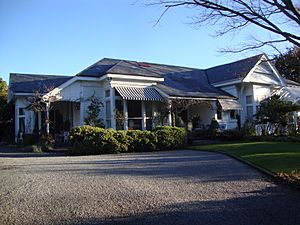John Joseph Dougall facts for kids
Quick facts for kids
John Joseph Dougall
|
|
|---|---|

Portrait of John Joseph Dougall
|
|
| 30th Mayor of Christchurch | |
| In office 31 July 1911 – 1 May 1912 |
|
| Preceded by | Tommy Taylor |
| Succeeded by | Henry Holland |
| Personal details | |
| Born | 1860 Aberdeenshire |
| Died | 5 September 1934 |
| Profession | solicitor |
John Joseph Dougall (born 1860 – died 1934) was a very important person in Christchurch, New Zealand. He served as the Mayor of Christchurch from 1911 to 1912. Before becoming mayor, he worked as a lawyer. Later in his life, he was very interested in the Navy League, which supported naval forces.
Contents
Early Life and Education
John Joseph Dougall was born in 1860 in Aberdeenshire, Scotland. He went to Greyfriars Parish School in Aberdeen. In 1871, when he was about 11 years old, he traveled to New Zealand with his younger brother Alexander and Mary Dougall on a ship called the Merope. The journey started in England and ended in Lyttelton on August 25.
Once in New Zealand, John Dougall continued his schooling at Mr. Gee's School in Christchurch.
His Career as a Lawyer
John Dougall began his training to become a lawyer in 1876. He worked for a company called Garrick, Cowlishaw and Co. In 1896, he officially became a solicitor, which is a type of lawyer, for the Supreme Court.
Later, he had an office with John Hazlitt Upham, who was the father of the famous soldier Charles Upham. They worked together as legal representatives for Australian States and South African colonies. John Dougall also became a director for Regent Street Limited, a company that helped build the well-known New Regent Street in Christchurch.
His Time in Politics
John Dougall was interested in local government. In 1896, he tried to become a council member for Linwood Borough but wasn't elected. However, he later became a member of the Riccarton Road Board, which managed roads in the area, from 1901 to 1910. He also joined the Christchurch Tramway Board, which looked after the city's tram system.
In 1909, he successfully ran for a spot on the Christchurch City Council for the Central Ward. He was elected again in 1911, this time getting the most votes in his ward.
Becoming Mayor of Christchurch
The mayor elected in April 1911, Tommy Taylor, sadly passed away after only three months in office. John Dougall stepped in as acting mayor. At the next council meeting on July 31, 1911, his fellow city councillors all voted for him to become the new mayor.
During his time as mayor, an important event happened: the foundation stone for the Government Building in Cathedral Square was laid. This ceremony was led by the Prime Minister, Sir Joseph Ward, with Mayor Dougall presiding. The city also made improvements, like extending Wordsworth Street to Colombo Street, which helped the tram routes. The city council also started discussions to buy the historic Canterbury Provincial Council Buildings from the government.
John Dougall ran for mayor again in April 1912 but was not re-elected. Henry Holland won the election and became the new mayor on May 1, 1912.
Community Involvement
John Dougall was very active in his community.
He was a volunteer with the Canterbury Militia and Volunteer District from 1878 to 1895, reaching the rank of lieutenant. In his later years, he was very dedicated to the Navy League. He served as the president of the Christchurch branch for 12 years and was also chairman of the New Zealand branch at one point.
Other Community Roles
John Dougall was a director of the Canterbury Caledonian Society, which celebrates Scottish culture. He was also a high-ranking member of the Freemasons, a fraternal organization.
He served on the Lyttelton Harbour Board for six years, helping manage the port. From 1916 until his death, he was a member of the board of governors for Canterbury College, which later became the University of Canterbury.
Family Life and Home

John Dougall married Harriet Catherine Wagner in 1886. They had five children: two sons and three daughters. Sadly, their second son, Walter, was killed in action during World War I in France in 1916.
In 1902, the Dougall family bought their home at 83 Clyde Road. This house is now famous as the Kate Sheppard House. It was previously owned by Walter Sheppard, the husband of Kate Sheppard, a leading figure in the women's suffrage movement. The house was a very important place for the women's suffrage campaign. The area around their home was quite rural at the time, and their property bordered land that later became part of the University of Canterbury campus.
John Dougall passed away in Christchurch on September 5, 1934, and was buried at Waimairi Cemetery. The family home was later sold in 1939. The house is now recognized as a very important heritage building because of its connection to Kate Sheppard and the fight for women's right to vote.

